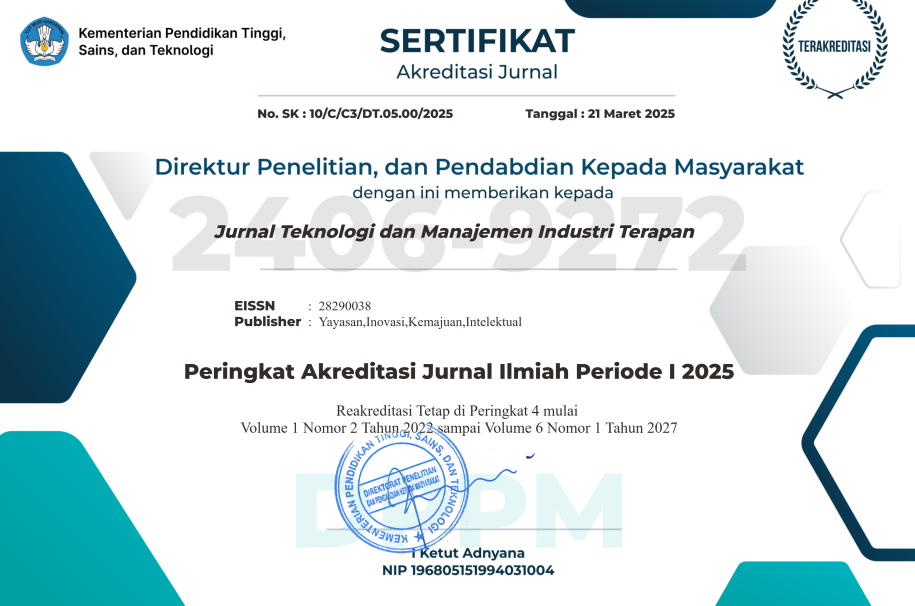Sistem Rekomendasi Warna Kontekstual untuk Desain UI/UX Menggunakan Random Forest
DOI:
https://doi.org/10.55826/jtmit.v4i3.1023Keywords:
UI/UX color prediction, Context-aware color recommendation, RGB and HSL features, Streamlit dashboard, Random Forest classification, SMOTE balancing, ADDIE modelAbstract
Pemilihan warna dalam desain antarmuka pengguna (UI/UX) memegang peranan penting dalam menciptakan pengalaman visual yang konsisten dan menarik. Namun, proses pemilihan warna masih sering didasarkan pada intuisi subjektif. Penelitian ini mengembangkan sistem rekomendasi warna kontekstual berdasarkan kategori aplikasi, menggunakan algoritma Random Forest. Dataset diperoleh dari Dribbble dan Kaggle, mencakup fitur warna RGB, HSL, serta fitur turunan lainnya. Proses pengembangan sistem mengikuti tahapan ADDIE, dimulai dari analisis hingga evaluasi performa. Eksperimen dilakukan dengan tahapan rekayasa fitur, pemilihan fitur, tuning parameter (GridSearchCV), serta penyeimbangan data menggunakan SMOTE. Model terbaik menghasilkan akurasi sebesar 39,2% dan menunjukkan peningkatan pada kategori aplikasi edukatif setelah balancing. Sistem ini diimplementasikan dalam bentuk dashboard interaktif berbasis Streamlit, memungkinkan pengguna memilih kategori aplikasi dan memperoleh rekomendasi warna secara visual. Penelitian ini merupakan kontribusi awal dalam integrasi klasifikasi warna berbasis konteks ke dalam proses desain UI digital, sebagai solusi berbasis data yang dapat mengurangi ketergantungan pada intuisi subjektif.
References
X. Li, Y. Li, and M. H. Jae, “Neural network’s selection of color in UI design of social software,” Neural Comput Appl, vol. 33, no. 3, pp. 1017–1027, Feb. 2021, doi: 10.1007/s00521-020-05422-4.
N. A. Karim et al., “Using interface preferences as evidence of user identity: A feasibility study,” International Journal of Data and Network Science, vol. 8, no. 1, pp. 537–548, Dec. 2024, doi: 10.5267/j.ijdns.2023.9.003.
R. Prasath and T. Kumanan, “Enhanced artificial bee colony approach for the enhancement and classification of underwater images,” International Journal of Computers and Applications, vol. 44, no. 5, pp. 433–443, 2022, doi: 10.1080/1206212X.2020.1784591.
W. Sha, K. Hu, and S. Weng, “Statistic and Network Features of RGB and Hyperspectral Imaging for Determination of Black Root Mold Infection in Apples,” Foods, vol. 12, no. 8, Apr. 2023, doi: 10.3390/foods12081608.
R. Bonacin, J. C. dos Reis, and R. J. de Araujo, “An ontology-based framework for improving color vision deficiency accessibility,” Univers Access Inf Soc, vol. 21, no. 3, pp. 691–716, Aug. 2022, doi: 10.1007/s10209-021-00791-6.
P. Park, H. Oh, and H. Kim, “Dual-color space network with global priors for photo retouching,” Sci Rep, vol. 13, no. 1, Dec. 2023, doi: 10.1038/s41598-023-47186-6.
P. M. Cuenca-Jiménez, J. Fernandez-Conde, and J. M. Cañas-Plaza, “FilterNet: Self-Supervised Learning for High-Resolution Photo Enhancement,” IEEE Access, vol. 10, pp. 2669–2685, 2022, doi: 10.1109/ACCESS.2021.3139778.
A. Zarindast and J. Wood, “A Data-Driven Personalized Lighting Recommender System,” Front Big Data, vol. 4, Oct. 2021, doi: 10.3389/fdata.2021.706117.
N. I. Papandrianos, A. Feleki, S. Moustakidis, E. I. Papageorgiou, I. D. Apostolopoulos, and D. J. Apostolopoulos, “An Explainable Classification Method of SPECT Myocardial Perfusion Images in Nuclear Cardiology Using Deep Learning and Grad-CAM,” Applied Sciences (Switzerland), vol. 12, no. 15, Aug. 2022, doi: 10.3390/app12157592.
A. Elangovan et al., “Imaging Sensor-Based High-Throughput Measurement of Biomass Using Machine Learning Models in Rice,” Agriculture (Switzerland), vol. 13, no. 4, Apr. 2023, doi: 10.3390/agriculture13040852.
C. Liu and J. Zhuang, “A Probabilistic Multi-Topic Model learned from Aesthetic Quality Communities for Dress Colors Recommendation,” IEEE Access, 2025, doi: 10.1109/ACCESS.2025.3559670.
L. Zhao, M. Li, and P. Sun, “Neo-Fashion: A Data-Driven Fashion Trend Forecasting System Using Catwalk Analysis,” Clothing and Textiles Research Journal, vol. 42, no. 1, pp. 19–34, Jan. 2024, doi: 10.1177/0887302X211004299.
A. Manzoor et al., “Inferring emotion tags from object images using convolutional neural network,” Applied Sciences (Switzerland), vol. 10, no. 15, Aug. 2020, doi: 10.3390/APP10155333.
J. Seo, A. Choi, and M. Sung, “Recommendation of indoor luminous environment for occupants using big data analysis based on machine learning,” Build Environ, vol. 198, Jul. 2021, doi: 10.1016/j.buildenv.2021.107835.
L. Museros, I. Sanz, Z. Falomir, and L. Gonzalez-Abril, “Creating, Interpreting and Rating Harmonic Colour Palettes Using a Cognitively Inspired Model,” Cognit Comput, vol. 12, no. 2, pp. 442–459, Mar. 2020, doi: 10.1007/s12559-018-9589-2.
Downloads
Published
How to Cite
Issue
Section
License
Copyright (c) 2025 Agita Nurfadillah, Roni Andarsyah, Rolly Maulana Awangga

This work is licensed under a Creative Commons Attribution-NonCommercial-ShareAlike 4.0 International License.


















